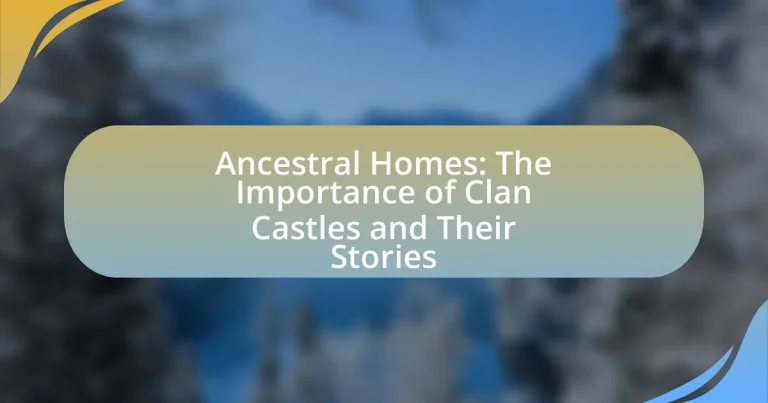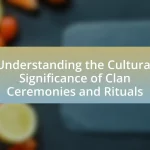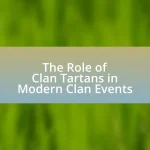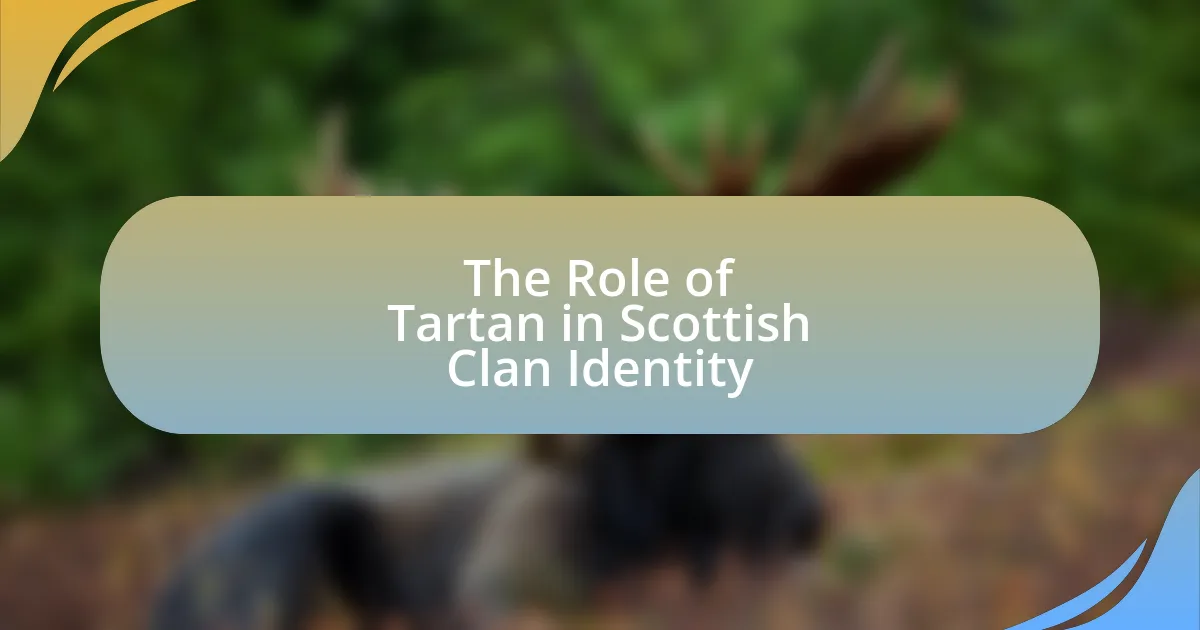Ancestral homes and clan castles are significant structures that embody the history, identity, and cultural heritage of families and clans. Ancestral homes are residences passed down through generations, while clan castles serve as fortified symbols of power and lineage. The article explores the architectural features, historical significance, and cultural roles of these structures, highlighting their importance in preserving family history and community identity. It also addresses contemporary challenges faced by ancestral homes and clan castles, including preservation efforts, funding options, and the impact of climate change and urban development. Through community involvement and local initiatives, the preservation of these historical sites is essential for maintaining cultural diversity and fostering a sense of belonging among descendants.
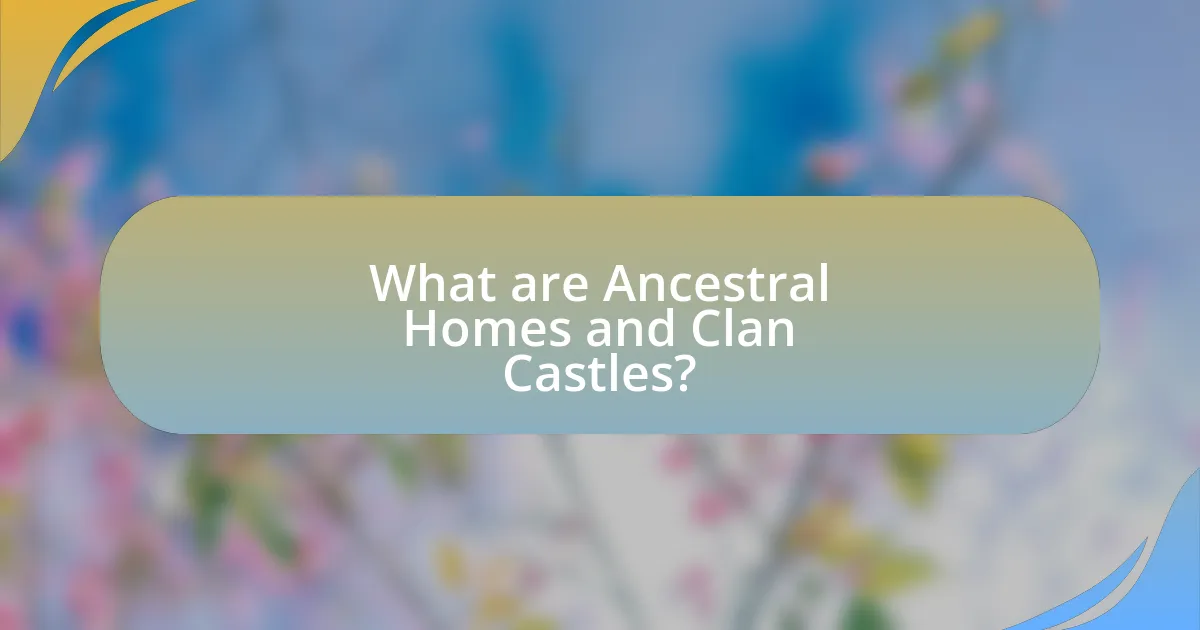
What are Ancestral Homes and Clan Castles?
Ancestral homes are residences that have been passed down through generations within a family, often holding significant historical and emotional value. Clan castles are fortified structures associated with specific clans or families, serving as both a residence and a symbol of power and heritage. These castles often reflect the architectural styles and defensive needs of their time, and many have historical significance, such as being the sites of important events or battles. For example, the Clan Campbell’s Inveraray Castle in Scotland showcases the family’s lineage and influence over centuries, illustrating the connection between ancestral homes and clan identity.
Why are Ancestral Homes significant in cultural heritage?
Ancestral homes are significant in cultural heritage because they serve as tangible links to history, identity, and tradition. These structures often embody the architectural styles, materials, and craftsmanship of their time, reflecting the cultural values and social structures of the communities that built them. For example, many ancestral homes are associated with specific clans or families, preserving genealogical records and stories that contribute to a collective memory. Furthermore, they often host cultural practices and rituals, reinforcing social cohesion and continuity within communities. The preservation of these homes is crucial for maintaining cultural diversity and fostering a sense of belonging among descendants.
What role do Clan Castles play in preserving family history?
Clan Castles serve as vital repositories of family history by housing artifacts, documents, and architectural features that reflect the lineage and heritage of clans. These structures often contain historical records, such as family trees and genealogical data, which provide insights into ancestral connections and significant events. For example, many Clan Castles have been maintained for centuries, allowing them to serve as physical reminders of the clan’s legacy, including battles fought, alliances formed, and cultural traditions upheld. The preservation of these castles often involves restoration efforts that aim to keep the stories and histories associated with the families alive, thereby reinforcing the identity and continuity of the clan across generations.
How do Ancestral Homes reflect the identity of a clan?
Ancestral homes reflect the identity of a clan by serving as physical embodiments of their history, values, and social structure. These homes often showcase architectural styles and materials that are unique to the clan’s geographical and cultural context, reinforcing a sense of belonging and continuity. For instance, many clans maintain specific symbols or motifs in their ancestral homes that represent their lineage and heritage, such as crests or family emblems. Additionally, the preservation of these homes often involves rituals and traditions that are integral to the clan’s identity, further solidifying their connection to the past. Historical records indicate that clans with well-maintained ancestral homes often exhibit stronger social cohesion and a clearer sense of identity, as these structures act as focal points for clan gatherings and celebrations.
What architectural features define Clan Castles?
Clan Castles are characterized by robust defensive structures, including thick stone walls, narrow windows, and fortified towers. These features were designed to withstand attacks and provide security for the clan members. Additionally, Clan Castles often include a central courtyard, which served as a gathering space, and a great hall for communal activities. The presence of a keep, or main tower, was common, serving as the residence for the clan leader and a last line of defense. Historical examples, such as Eilean Donan Castle in Scotland, illustrate these architectural elements, showcasing the blend of functionality and status that defined Clan Castles.
How do the designs of Clan Castles vary across regions?
The designs of Clan Castles vary significantly across regions due to historical, geographical, and cultural influences. For instance, Scottish Clan Castles often feature thick stone walls and defensive structures, reflecting the need for protection against invasions, while Irish Clan Castles may incorporate more ornate architectural styles, showcasing the influence of the Gaelic revival and local craftsmanship. Additionally, the layout and materials used in these castles can differ; for example, castles in the Highlands are typically built from local granite, whereas those in the Lowlands might utilize sandstone. These regional variations highlight the adaptation of Clan Castles to their specific environments and the historical context of the clans that built them.
What materials are commonly used in the construction of Clan Castles?
Clan Castles are commonly constructed using stone, timber, and mortar. Stone provides durability and strength, while timber is often used for structural elements and roofing. Mortar serves as a binding agent to hold the stone together. Historical evidence shows that many clan castles were built from locally sourced materials, reflecting the geographical and environmental context of their locations, which further supports the use of these materials in their construction.
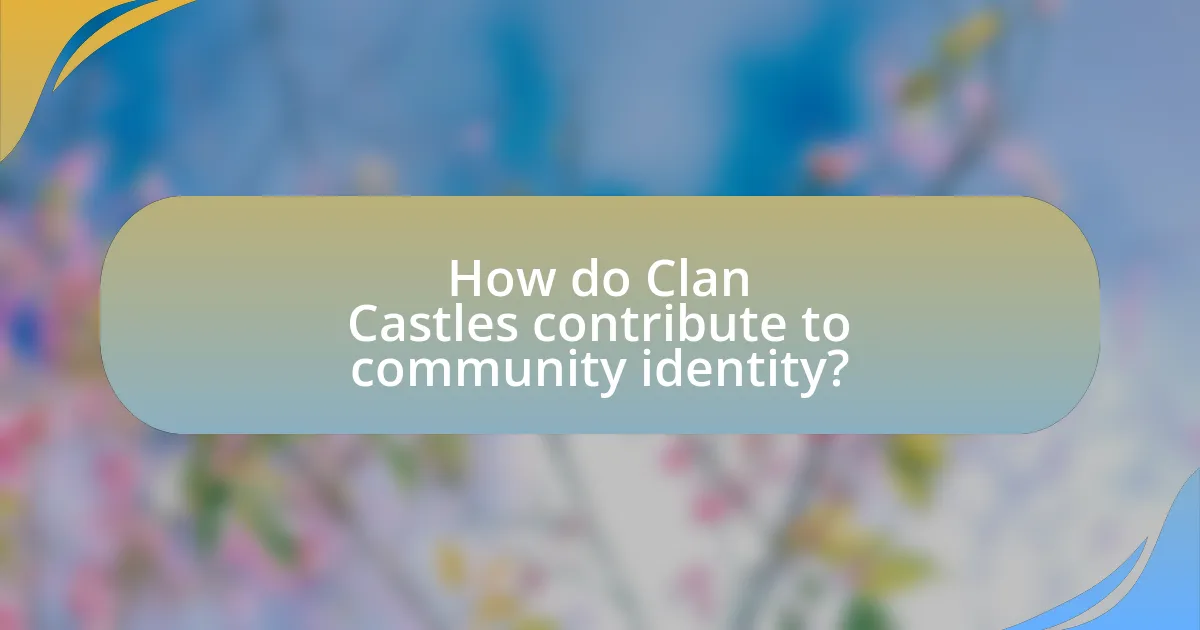
How do Clan Castles contribute to community identity?
Clan Castles serve as vital symbols of community identity by embodying the historical and cultural heritage of the clans they represent. These structures often act as focal points for clan gatherings, rituals, and celebrations, reinforcing social bonds among members. For instance, many Scottish clans utilize their ancestral castles for events that celebrate their lineage, thus fostering a sense of belonging and continuity. Additionally, Clan Castles often house artifacts and stories that reflect the clan’s unique history, further solidifying their role in shaping community identity. The preservation and promotion of these castles contribute to a shared narrative that enhances collective memory and pride within the community.
In what ways do Clan Castles serve as gathering places?
Clan Castles serve as gathering places by providing a central location for clan members to convene for social, political, and ceremonial purposes. These structures often host important events such as clan meetings, celebrations, and rituals, fostering a sense of community and shared identity among members. Historically, Clan Castles have been strategically located to facilitate access for clan members, reinforcing their role as hubs of social interaction and cultural continuity.
What events are typically held at Clan Castles?
Clan Castles typically host events such as clan gatherings, weddings, and historical reenactments. These events serve to strengthen community ties and celebrate heritage, often featuring traditional music, dance, and storytelling that reflect the clan’s history. For instance, clan gatherings often coincide with local festivals or anniversaries, allowing members to reconnect and honor their lineage. Historical reenactments provide educational opportunities, showcasing the castle’s significance in the clan’s past and preserving cultural traditions.
How do Clan Castles foster connections among clan members?
Clan Castles foster connections among clan members by serving as physical and symbolic spaces for gathering, collaboration, and shared identity. These structures often host clan meetings, celebrations, and rituals, which strengthen interpersonal bonds and reinforce a sense of belonging. Historical records indicate that clan castles were central to community life, facilitating communication and cooperation among members, thereby enhancing social cohesion and collective identity.
What stories are associated with Clan Castles?
Clan Castles are associated with numerous historical and legendary stories that reflect the heritage and culture of the clans they represent. These stories often include tales of battles, feuds, and alliances that shaped the clans’ identities, such as the legendary conflicts between the MacLeods and the MacDonalds on the Isle of Skye. Additionally, many Clan Castles are linked to folklore, including ghost stories and myths about their founders, like the tale of the ghost of Lady Mary of Castle Menzies, who is said to protect her ancestral home. These narratives not only serve to preserve the history of the clans but also reinforce their cultural significance in Scottish heritage.
How do legends and folklore enhance the significance of Clan Castles?
Legends and folklore enhance the significance of Clan Castles by embedding cultural narratives and historical context that deepen their meaning. These stories often recount the heroic deeds of clan leaders, battles fought, and the origins of the clan, which create a sense of identity and continuity for descendants. For instance, the tale of the legendary warrior who defended a castle against invaders not only glorifies the clan’s past but also fosters pride among current members. Additionally, folklore associated with specific castles, such as ghost stories or mythical creatures, attracts tourism and preserves local traditions, further solidifying the castle’s role as a cultural landmark. This interplay of narrative and heritage underscores the castles’ importance as symbols of clan legacy and community cohesion.
What historical events are linked to specific Clan Castles?
Clan castles are linked to numerous historical events that shaped Scottish history. For instance, Eilean Donan Castle is associated with the Jacobite risings, particularly the 1719 attempt to restore the Stuart monarchy, where it served as a stronghold for the Jacobite forces. Similarly, Stirling Castle played a crucial role during the Wars of Scottish Independence, notably in the Battle of Stirling Bridge in 1297, where William Wallace achieved a significant victory against the English. Furthermore, Castle Campbell is linked to the Campbell clan’s involvement in the 17th-century conflicts, including the Civil War, where it served as a strategic military base. These events illustrate the castles’ significance as both military strongholds and symbols of clan identity throughout Scottish history.

What challenges do Ancestral Homes face today?
Ancestral homes face significant challenges today, including financial strain, maintenance issues, and changing societal values. Many ancestral homes require substantial funds for upkeep, which can be difficult for families to manage, especially if the property is not generating income. Additionally, the physical deterioration of these homes due to age and lack of resources for restoration poses a serious threat to their preservation. Furthermore, as modern lifestyles evolve, the cultural significance of ancestral homes may diminish, leading to a decline in interest among younger generations to maintain these properties. These challenges highlight the need for targeted preservation efforts and financial support to ensure the survival of ancestral homes.
How is preservation of Clan Castles approached in modern times?
The preservation of Clan Castles in modern times is approached through a combination of restoration efforts, heritage conservation practices, and community engagement. Organizations such as Historic Environment Scotland actively work to maintain these structures, ensuring they are protected under heritage laws and receive necessary funding for restoration projects. For instance, the restoration of the Clan Campbell’s Inveraray Castle involved significant investment to preserve its historical integrity while adapting it for modern use, including tourism. Additionally, local clans often engage in fundraising and awareness campaigns to support preservation efforts, highlighting the cultural significance of these castles to their heritage.
What funding options are available for maintaining Clan Castles?
Funding options for maintaining Clan Castles include government grants, private donations, crowdfunding campaigns, and heritage lottery funds. Government grants often support historical preservation, while private donations can come from individuals or organizations interested in heritage conservation. Crowdfunding campaigns leverage community support to raise funds, and heritage lottery funds specifically allocate resources for the preservation of historical sites. These funding avenues are essential for ensuring the upkeep and restoration of Clan Castles, which serve as significant cultural and historical landmarks.
How do climate change and urban development threaten Clan Castles?
Climate change and urban development threaten Clan Castles primarily through increased erosion, flooding, and habitat loss. Rising sea levels and extreme weather events, driven by climate change, can lead to the deterioration of castle structures and surrounding landscapes. For instance, coastal Clan Castles are particularly vulnerable to storm surges and erosion, which can undermine their foundations. Urban development encroaches on these historical sites, often resulting in the destruction of their cultural context and physical integrity. The construction of infrastructure and housing can lead to the displacement of these castles, as well as increased pollution and traffic that further degrade their surroundings. These factors collectively jeopardize the preservation of Clan Castles, which are vital to cultural heritage and history.
What role do communities play in the preservation of Clan Castles?
Communities play a crucial role in the preservation of Clan Castles by actively engaging in restoration efforts, fundraising, and promoting awareness of their historical significance. Local residents often form organizations dedicated to maintaining these structures, which serve as cultural heritage sites. For instance, community-led initiatives can include volunteer restoration projects, educational programs, and events that celebrate the history of the clan associated with the castle. These efforts not only help to secure funding and resources but also foster a sense of identity and pride among community members, ensuring that the stories and traditions linked to Clan Castles are passed down through generations.
How can local initiatives support the conservation of Ancestral Homes?
Local initiatives can support the conservation of Ancestral Homes by fostering community engagement and providing resources for restoration projects. These initiatives often involve local governments, non-profit organizations, and community groups that collaborate to raise awareness about the historical significance of these homes. For example, initiatives may include educational programs that highlight the cultural heritage associated with Ancestral Homes, encouraging residents to participate in preservation efforts. Additionally, funding opportunities, such as grants or tax incentives, can be made available to homeowners for restoration work, ensuring that these structures are maintained for future generations. Evidence of successful local initiatives can be seen in various regions where community-led efforts have resulted in the preservation of historically significant sites, demonstrating the effectiveness of grassroots involvement in conservation.
What are the benefits of community involvement in preservation efforts?
Community involvement in preservation efforts enhances cultural heritage, fosters local identity, and promotes sustainable practices. Engaging community members in preservation initiatives leads to increased awareness and appreciation of historical sites, as evidenced by studies showing that local participation can improve the success rates of preservation projects by up to 30%. Furthermore, when communities actively participate, they contribute valuable local knowledge and resources, which can result in more effective and culturally relevant preservation strategies. This collaborative approach not only strengthens community bonds but also ensures that preservation efforts are aligned with the values and needs of the local population.
What practical steps can individuals take to support Clan Castles?
Individuals can support Clan Castles by participating in preservation efforts, such as volunteering for restoration projects or donating to organizations dedicated to maintaining these historical sites. Engaging in local heritage events and promoting awareness through social media can also help garner community support. According to the National Trust for Scotland, community involvement in heritage conservation has proven effective in sustaining historical sites, as it fosters a sense of ownership and responsibility among local populations.
How can one get involved in local heritage organizations?
To get involved in local heritage organizations, one can start by researching and identifying specific organizations in their area that focus on heritage preservation. Many local heritage organizations welcome volunteers for various activities, including restoration projects, educational programs, and community events. Engaging with these organizations often involves attending meetings, participating in events, or volunteering for specific tasks, which can be found on their websites or through local community boards. According to the National Trust for Historic Preservation, community involvement is crucial for the sustainability of heritage sites, as it fosters a sense of ownership and responsibility among local residents.
What resources are available for learning about Clan Castle history?
Resources for learning about Clan Castle history include historical texts, academic journals, and online databases. Notable historical texts such as “The Castles of Scotland” by Martin Coventry provide detailed accounts of various clan castles, including their architectural features and historical significance. Academic journals like “Scottish Historical Review” often publish articles that explore the socio-political context of clan castles. Additionally, online databases such as the National Records of Scotland offer access to primary documents and records related to clan history. These resources collectively provide a comprehensive understanding of Clan Castle history.
